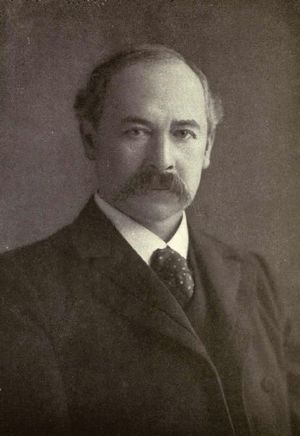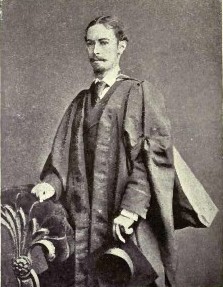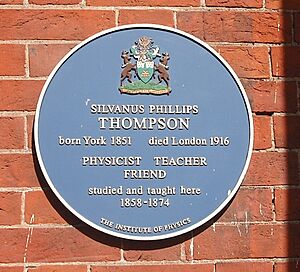Silvanus P. Thompson facts for kids
Quick facts for kids
Silvanus P. Thompson
|
|
|---|---|

Photograph from Thompson's obituary in the Proceedings of the Royal Society
|
|
| Born |
Silvanus Philips Thompson
19 June 1851 York, England
|
| Died | 12 June 1916 (aged 64) London, England
|
| Education | University of London Royal School of Mines |
| Known for | Calculus Made Easy (1910) |
| Scientific career | |
| Fields | Physics Electrical engineering |
| Institutions | University College, Bristol City and Guilds of London Institute
British Institute of Radiology |
| Signature | |
Silvanus Phillips Thompson FRS (born June 19, 1851 – died June 12, 1916) was an English professor. He taught physics at the City and Guilds Technical College in Finsbury, England. He became a member of the important Royal Society in 1891. Thompson was well-known for his work as an electrical engineer and as a writer.
His most famous book is Calculus Made Easy, published in 1910. This book helps people learn the basics of infinitesimal calculus, which is a type of advanced math. It is still printed and used today! Thompson also wrote a popular science book called Elementary Lessons in Electricity and Magnetism. He also wrote biographies about famous scientists like Lord Kelvin and Michael Faraday.
Contents
Early Life and Education
Silvanus Thompson was born on June 19, 1851, in York, England. His family were Quakers, a Christian group. His father was a teacher at the Quaker Bootham School in York, where Silvanus also studied. Later, in 1873, Silvanus Thompson became a science teacher at the same school.
He earned his first degree, a Bachelor of Arts, from the University of London in 1869. After teaching for a while, he won a scholarship to the Royal School of Mines (RSM) in London. There, he studied chemistry and physics. He graduated with high honors and started working at RSM. He soon joined the Royal Astronomical and Physical Society. He often attended meetings where scientists showed exciting experiments.
Discovering a Passion for Light
On February 11, 1876, Thompson attended a talk by Sir William Crookes at the Royal Institution. Crookes showed his "light mill," also known as a Crookes radiometer. This device spins when light hits it. Thompson was very interested and excited by this demonstration. It sparked a major interest in light and optics (the study of light). His other main interest was electromagnetism, which is about electricity and magnets.
In 1876, he became a lecturer in physics at University College, Bristol. By 1878, at just 27 years old, he became a full Professor there.
Champion of Technical Education
Thompson cared a lot about how people learned technical skills. He traveled to France, Germany, and Switzerland to see how other countries taught these subjects. In 1879, he gave a speech where he talked about how England's technical education needed to improve. He believed that technical education was key to using scientific knowledge in real life. He spent the rest of his life working to make his ideas happen.
In 1878, the City and Guilds of London Institute was created to help improve technical education. Finsbury Technical College was a school started by this Institute. Thompson became its Principal and Professor of Physics. He worked there for the next 30 years, shaping how students learned about science and engineering.
A Gift for Explaining Science
Thompson was especially good at explaining difficult scientific ideas in a clear and interesting way. He often gave lectures at the Royal Institution. In 1896, he gave the famous Royal Institution Christmas Lectures on Light, Visible and Invisible. He even talked about Röntgen Light, which we now call X-rays. People who heard him speak said he painted "vivid word-pictures" that made science easy to understand.

Innovations in Communication and X-rays
In 1891, Thompson came up with an idea for a new type of telegraph submarine cable. This cable would help electrical signals travel farther and faster. This would make sending messages across the ocean much quicker. His design helped improve submarine telegraphy, which was important for future telephone systems under the sea.
Thompson was also quick to explore X-rays. The day after X-rays were discovered in the UK, he repeated Wilhelm Röntgen's experiments. He then gave the first public demonstration of these new rays in London on March 30, 1896. People were amazed to see actual bones and metal inside objects for the first time.
He became the first President of the Röntgen Society, which later became the British Institute of Radiology. He saw this society as a bridge between medicine, physics, and photography. His vision helped make it a place where doctors, scientists, and technical experts could work together.
Later Life and Legacy
In 1900, Thompson was involved in a situation regarding Marconi's patents for wireless telegraphy. The Post Office asked Thompson and another professor, Oliver Lodge, to write secret reports. They wanted to see if Marconi's patents could be challenged or if similar equipment could be made differently.
Thompson believed strongly in truth and honesty. In 1915, he gave a lecture called The Quest for Truth to the Society of Friends. This showed his belief in truth and honesty in all parts of life. He remained an active member of the Religious Society of Friends throughout his life.
Silvanus Thompson passed away in London on June 12, 1916, after a short illness. He left behind his wife and four daughters.
Literary Works and Interests
Thompson wrote many technical books. Some of his most important ones include Elementary Lessons in Electricity & Magnetism (1881) and Dynamo-electric Machinery (1884). His classic book, Calculus Made Easy, was first published in 1910 and is still available today.
Beyond science, Thompson had many other interests. He enjoyed painting, reading, learning about the history of science, and working in his greenhouse. He wrote biographies of famous scientists like Michael Faraday and Lord Kelvin. He also wrote about William Gilbert, an Elizabethan doctor, and helped publish Gilbert's book De Magnete in 1900. In 1912, Thompson also published the first English translation of Treatise on Light by Christiaan Huygens.
His personal library of historical and scientific books is kept at the Institution of Electrical Engineers. It is a wonderful collection with many classic books on electricity, magnetism, and optics. The collection includes 900 rare books and thousands of books from the 1800s and early 1900s.
Honors and Inventions
- Thompson is honored on the Engineers Walk in Bristol, England.
- He was chosen as a Fellow of the Royal Society on May 14, 1891.
- He became a member of the Royal Swedish Academy of Sciences in 1894.
- In 1902, he was elected a member of the American Philosophical Society.
Thompson also invented the permeameter, a device used to measure magnetic properties. In 1910, he was involved in early attempts to use magnetic fields to stimulate the brain in London. Many years after his death, this technique became known as Transcranial Magnetic Stimulation.
Images for kids




